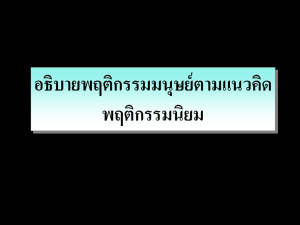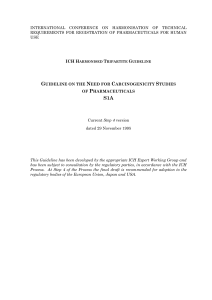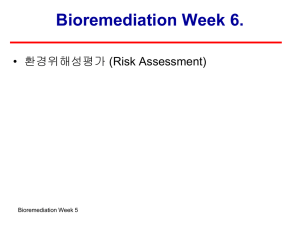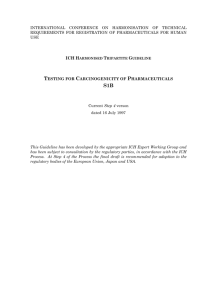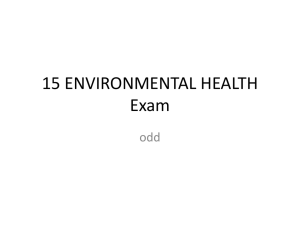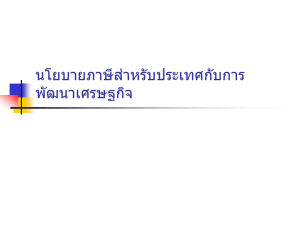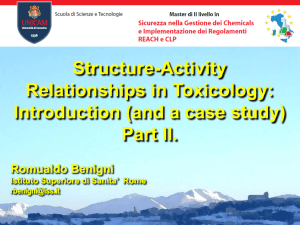Dose - สำนักอนามัยสิ่งแวดล้อม
advertisement
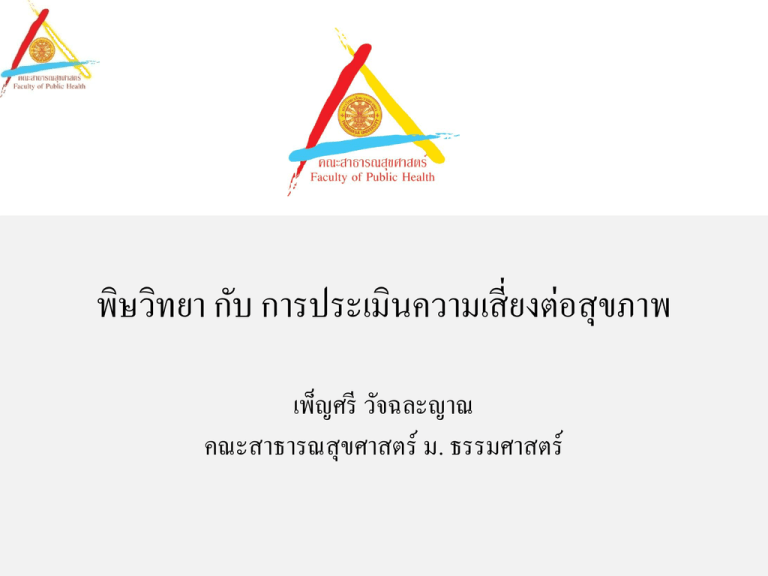
พิษวิทยา กับ การประเมินความเสี่ ยงต่อสุ ขภาพ เพ็ญศรี วัจฉละญาณ คณะสาธารณสุ ขศาสตร์ ม. ธรรมศาสตร์ นิยาม ความเสี่ ยง หมายถึง ลักษณะของ สถานการณ์หรื อการกระทาใดๆที่มี ผลลัพธ์ได้มากกว่า 1 อย่าง โดยไม่ สามารถบอกได้อย่างแน่นอนว่าจะเกิด ผลลัพธ์น้ นั ๆได้หรื อไม่ และอย่างน้อย หนึ่งในผลลัพธ์น้ นั ไม่พึงประสงค์ องค์ ประกอบความเสี่ ยง • โอกาสของการเกิด Probability / ความไม่แน่นอน Uncertainty • เหตุการณ์ไม่พึงประสงค์ Consequence แนวคิด มลพิษกับผลกระทบต่อสุ ขภาพ กิจกรรม/แหล่งกำเนิด อุตสาหกรรม/ กิจกรรม เกษตรกรรม พลังงาน ของเสี ย ชุมชน การขนส่ง กำรปล่อยมลพิษ Emission การเคลือ ่ นยาย ้ การเปลีย ่ นรูป Fate ควำมเข้มข้นในสิ่งแวดล้อม อากาศ น้า อาหาร ดิน กำรได้รบั สัมผัส ผลกระทบต่อสุขภำพ ปริมำณในร่ำงกำย Adapted from Briggs et al, 1996 Subclinical effects เจ็บป่วย ตาย Fate and Transport of Pollutants in Environment มลพิษในสิ่ งแวดล้อม • มลพิษสามารถเข้าสู่สิ่งแวดล้อมได้หลายช่องทาง • มลพิษส่ วนใหญ่อยูใ่ นสื่ อสิ่ งแวดล้อมมากกว่า 1 อย่าง • ตัวอย่างเช่น สารเบนซีนจากน้ ามันเชื้อเพลิงที่ รั่วไหล/หกรด/ จะ ปนเปื้ อนดินในช่วงต้น ต่อมาบางส่ วนก็จะระเหยเข้าสู่อากาศ บางส่ วนก็ จะซึมผ่านชั้นดินเข้าสู่น้ าใต้ดิน ขั้นตอนที่ 2 ขนาดสัมผัสกับการตอบสนอง การตอบสนองของร่ างกายต่อสารพิษ • การเกิดพิษในร่ างกาย: การเกิดพิษ/การทนทานต่อสารพิษ – การเกิดพิษแบบเฉี ยบพลัน (acute toxicity) เกิดอาการภายหลังได้รับสาร เพียงครั้งเดียว หรื อหลายครั้งภายใน 24 ชม. ก่อให้เกิดอาการ เช่น ตาย อาเจียน มึนงง หรื อ ชัก เป็ นต้น มักเกิดจากการได้รับสารในปริ มาณมาก – การเกิดพิษแบบเรื้ อรัง (chronic toxicity) เกิดอาการภายหลังได้รับสาร ปริ มาณน้อยๆติดต่อกันมากว่า 3 เดือน • การเกิดมะเร็ ง Carcinogenicity • การกลายพันธุ์หรื อการผ่าเหล่าของเซลล์ Mutagenicity • การเกิดลูกวิรูป Teratogenicity • การผิดปกติของระบบภูมิคุม้ กัน Immunotoxicity ความเป็ นพิษของสารเคมี 1. การขาดอากาศหายใจ 2. การระคายเคืองต่อผิวหนังและเยือ่ บุชุ่ม 3. ทาอันตรายต่อระบบการสร้างโลหิ ต 4. ทาอันตรายต่อระบบประสาท 5. มีการเปลี่ยนแปลงกระบวนการเมตาบอลิซึม ความเป็ นพิษของสารเคมี 6. ทาอันตรายต่อกระดูก 7. ทาอันตรายต่อระบบการหายใจ 8. ทาให้เกิดการเปลี่ยนแปลงพันธุกรรม 9. ทาให้เกิดมะเร็ ง 10. ทาให้ทารกในครรภ์พิการ การเกิดพิษของตัวทาละลาย 1. พิษแบบเฉียบพลัน เกิดทันที เช่น ระคายเคืองเยื่อบุทางเดินหายใจ ผิวหนัง และทาให้ผิวหนัง อักเสบ ฝันหวาน ร่ าเริ ง ตื่นเต้น ต่อมาเหมือนเมาเหล้า คือปวดศีรษะ มึนงง คลื่นไส้ อาเจียน อ่อนเพลีย ประสาทหลอน และควบคุมตัวเองไม่ได้ 2. พิษแบบเรื้ อรัง รับทีละน้อยแต่นานปี กลุ่มเป้ าหมาย เช่น สมอง ตับ ไต ตั้งแต่ อวัยวะผิดปกติ จนถึงล้มเหลว บางตัวเป็ นสารก่อมะเร็ ง พิษเฉียบพลัน ≠ พิษเรื้ อรัง การกิน ≠ การหายใจ ตัวอย่างพิษเฉี ยบพลัน พิษเรื้ อรัง สารมลพิษ พิษเฉียบพลัน สารหนู อนินทรี ย ์ เมื่อกิน เกิดความผิดปกติของระบบทางเดิน อาหาร อาเจียน ท้องร่ วง และ ชัก ระบบ ประสาทส่ วนกลางผิดปกติ ปวดศีรษะ แคดเมี่ยม เมื่อกิน มีอาการคลื่นไส้ อาเจียน ท้องเสี ย ปวดศีรษะ ปวดกล้ามเนื้อ มีน้ าลายไหล ปวดท้อง ช็อค(Shock) ไตและตับถูกทาลาย MTBE พิษเรื้อรัง ผิวหนังเป็ นปุ่ มหนาสี คล้ า ผมร่ วง หนังตาบวมพอง และก่อให้เกิด มะเร็งผิวหนัง มีผลต่อไต และกระดูก มีอาการ ปวดร้าว แต่หากได้รับทางการ หายใจก่อให้เกิดมะเร็ งปอด ทาให้เกิดการระคายเคืองต่อเยือ่ บุผวิ มีผล ตับและไตโต เกิดบาดแผลที่ไต ต่อระบบประสาท ทาให้เกิดอาการวิงเวียน เพิม่ ความเสี่ ยงในการแท้ง หรื อ ปวดศีรษะ และคลื่นไส้อาเจียน การตายของทารกในครรภ์ ประวัตพ ิ ษิ วิทยา Paracelsus (1493-1541) “Father of toxicology” เกิดที่ Salzburg, Austria alchemist, physician, astrologer, and Philippus Theophrastus Aureolus Bombastus von Hohenheim general occultist “All substances are poisons; there is none which is not a poison. The right dose differentiates a poison from a remedy.” Paracelsus formulated many views that remain an integral part of modern toxicology •Experimentation is essential in examination of responses to chemicals •Distinctions should be made between therapeutic and toxic properties of chemicals •These properties are sometimes only distinguishable by dose Thalidomide The drug is a potent teratogen in rabbits and primates including humans: severe birth defects may result if the drug is taken during pregnancy.[2] Thalidomide was sold in a number of countries across the world from 1957 until 1961 when it was withdrawn from the market after being found to be the cause of what has been called "the biggest medical tragedy of modern times".[3] It is not known exactly how many worldwide victims of the drug there have been, although estimates range from 10,000 to 20,000.[4] Minamata • a neurological syndrome caused by severe mercury poisoning, discovered in 1956 • This highly toxic chemical bioaccumulated in shellfish and fish in Minamata Bay and the Shiranui Sea. • While cat, dog, pig, and human deaths continued over more than 30 years. • 2,265 victims had been officially recognised (1,784 of whom had died) and over 10,000 had received financial compensation from Chisso. By 2004, Chisso Corporation had paid $86 million in compensation, and in the same year was ordered to clean up its contamination. http://en.wikipedia.org/wiki/Minamata_disease soshisha.org japanfocus.org nimd.go.jp Agent Orange, a herbicide and defoliant, used by the U.S. military in its Warfare program during the Vietnam War, when an estimated 21,136,000 gal. (80,000 m³) of Agent Orange were sprayed across South Vietnam. 4.8 million Vietnamese people were exposed to Agent Orange, resulting in 400,000 deaths and disabilities, and 500,000 children born with birth defects. 2,4-dichlorophenoxyacetic acid (2,4-D) and 2,4,5trichlorophenoxyacetic acid (2,4,5-T) 2,4-D 2,4, 5-T http://en.wikipedia.org/wiki/Agent_Orange ทางเข้าสู่ร่างกายของสารเคมี การกิน (Ingestion) การดูดซึม (Absorption) การหายใจ (Inhalation) การฉีด (Injection) แหล่งกาเนิด ช่องทางการได้รับสัมผัส Exposure Pathway ความเข้มข้นของการได้รับสัมผัส Exposure concentrations ทางเข้าสู่ ร่างกาย หายใจ/ กิน /ผิวหนัง ปริ มาณที่คาดว่าได้รับ Potential Dose uptake ปริ มาณภายในร่ างกาย Internal Dose ปริ มาณที่ส่งผลกระทบทางชีวภาพ Biological Effective Dose ผลกระทบทางชีวภาพ Biological Effect http://thumbs.dreamstime.com/thumb_50 1/1273097648xc62C1.jpg อาการไม่พึงประสงค์ Adverse Effect สิ่งแวดล้อม ความเข้มข้นในสิ่ งแวดล้อม เช่น ดิน/ อาหาร /น้ า /อากาศ/ สิ นค้า อุปโภคหรื อบริ โภคต่างๆ คน Biomarker of Exposure Exposure Internal Dose Benzene - Blood Benzene - Specific Urinary Meatbolite Exposure assessment Biomarker of Early Effect Biological Effective Dose DNA Adducts Early Biological Effect - DNA Damage - DNA Repair Capacity Risk assessment Disease Cancer Dose-response models Measure mortality after a certain exposure period (e.g. after 48 h… or 5 days…) Dose-Response Graphs: cumulative in log normal distribution LD 50 % Mortality Rate 50 0 28 Dose (mg/kg-day) Lethal dose • ข้อมูลพิษเฉียบพลันที่นิยมใช้ คือ ค่า mean lethal dose (LD50) และ mean lethal concentration (LC50) LD50 และ LC50 • หมายถึง ปริ มาณสารเคมีที่ทาให้สัตว์ทดลองตาย 50 % ของสัตว์ทดลอง ทั้วงหมด มีหน่วยเป็ น มก./กก.นนตัว • เป็ นข้อมูลพื้นฐานที่หน่วยงานและองค์กรต่างๆ นามาใช้ในการจัดกลุ่ม สารเคมีหรื อ ban สารเคมี การจัดกลุ่มสารพิษ ระดับความเป็ นพิษ LD50 โดยการให้ทางปาก* ของแข็ง ของเหลว LD50 โดยการป้ ายบนผิวหนัง* ของแข็ง ของเหลว Ia พิษร้ายแรงมาก extremely hazardous <5 < 20 < 10 < 40 Ib พิษร้ายแรง highly Hazardous > 5 - 50 > 20 - 200 > 10 - 100 > 40 - 400 > 50 - 500 > 200 - 2,000 > 100 - 1,000 > 400 - 4,000 > 500 > 2,000 > 1,000 > 4,000 II พิษปานกลาง moderately hazardous III พิษน้อย slightly hazardous ที่มา : WHO (2004) The WHO Recommended Classification of Pesticides by Hazard and Guidelines to Classific. World Health Organization. Geneva, Switzerland * หน่วย = มก./กก.นนตัว ปริ มาณสารพิษ และการตอบสนอง Toxic chemicals Polychlorinated biphenyls (PCBs) Ethanol Sodium chloride (Table salt) Ferrous sulfate (nutritional supplement) Malathion -pesticide Morphine Phenobarbital-sedative Tylenol- acetaminophen Strychnine Nicotine Botulinum toxin – food poison Ranking ปริ มาณสารพิษ และการตอบสนอง Toxic chemicals Polychlorinated biphenyls (PCBs) Ethanol LD50 (mg/kg) 15,000 10,000 Sodium chloride (Table salt) Ferrous sulfate (nutritional supplement) Malathion -pesticide Morphine 4,000 1,500 1,375 900 Phenobarbital-sedative Tylenol- acetaminophen Strychnine- a rat poison 150 142 2 Nicotine Botulinum toxin – food poison 1 0.00001 ความเป็ นพิษของสารฆ่าแมลงในหนูถีบจักร สารพิษ ดีลดริ น พาราไธออน ไตรฟลูเพอริ คอล ดิจิทอกซิ น ค่า LD50 มก./กก. นน. ตัว เพศเมีย เพศผู ้ 119 3.6 140 56 213 9 360 94 Toxicokinetic models กระบวนการของร่ างกายต่อสารพิษ • ประกอบด้วย 4 กระบวนการ – กระบวนการรับสารพิษเข้าสู่ร่างกายและการดูดซึม – การกระจายตัวและการสะสม – การเปลี่ยนโครงสร้างสารพิษ (Biotransformation/Metabolism) – การกาจัด วิถีของสารพิษในร่ างกาย Lead Absorption • Gastrointestinal Tract – 8% absorbed (adult) – 50% absorbed (children) – Ca++, Fe++ decrease absorption • Respiratory Tract - Particle size • Chemical form • Skin - Does occur at high exposures ปัจจัยที่มีผลต่อการเกิดพิษ • ปริ มาณที่ได้รับเข้าสู่ร่างกาย • ลักษณะทางกายภาพและเคมีของสารเคมี เช่น ก๊าซ ไอระเหย ละอองอนุภาค เส้นใย ฟูม • วิถีเข้าสู่ ร่างกายที่แตกต่างกันนั้นอาจมีผลต่อร่ างกายแตกต่างกัน • สถานะสุ ขภาพของบุคคลที่ได้รับ แข็งแรง/ เจ็บป่ วย/ตั้งครรภ์ • ปัจจัยทางชีวภาพและพันธุกรรม อายุ /เพศ Exposure Assessment & the Environmental Health Paradigm Sexton (1992) Exposure Assessment Sources (s) • Properties Amount Released/Used Location/Setting Concentrations Air Water Soil/Dust Food Surfaces Human Exposures Route Magnitude Duration Frequency Effects Assessment Internal Dose Absorbed Dose Target Dose Biomarkers Health Effect (s) Cancer Non Cancer o Damage/Disease o Signs/Symptoms การประเมินขนาดสัมผัสและการตอบสนอง การประเมินขนาดการสัมผัสและการตอบสนอง แบ่งเป็ น 2 แบบ 1. การเกิดโรคอืน่ ที่ไม่ ใช่ โรคมะเร็ง: Non cancer endpoint * หลักการ มีค่าที่ยอมให้ รับได้ Threshold • Reference Dose (RfD) = หมายถึง ปริ มาณสารเคมีที่มนุษย์สามารถรับเข้าสู่ ร่ างกายได้ทุกวัน โดยไม่ทาให้เกิดความผิดปกติใดๆ ต่อสุ ขภาพอนามัย • ตัวอย่างเช่น สารเบนซี น Benzene RfDi = 1.7 mg/kg bw.-day 2. การเกิดมะเร็ง Cancer endpoint * หลักการ ไม่ มีค่าที่ยอมให้ รับได้ No Threshold • Slope factor (carcinogenic potency slope) • ตัวอย่างเช่น Benzene CPSi = 2.9 E-2 (mg/kg bw.-day)-1 www.epa.gov/iris % Response Dose-Response Curves (non-carcinogens) RfD NOAEL LOAEL Dose (mg/kg-day) 36 Reference Dose (RfD) Reference Dose RfD = (NOAEL) / (UFxMF) NOAEL = No Observable Adverse Effect Level UF = Uncertainty Factor 10x Animals to Man 10x, Susceptibility 10x, Only Acute Studies 1-10x, Others MF = Modifying Factors หมายถึง factor ที่แสดงถึงความสมบูรณ์และ ความน่าเชื่อถือของข้อมูลที่นามาใช้ 50 NOAEL 0 7 Dose mg/kg 28 0.15 occurrence of cancer 0.1 95% upper confidence limit 0.05 0 0 200 Human exposure 400 600 Dose (mg/kg-day) 800 1000 Animal experiments ตัวอย่าง ค่า RfD และ CPS สารมลพิษ สารหนู อนินทรี ย ์ แคดเมี่ยม MTBE RfD CPS 3 x 10-4 mg/kg-day 5 x 10-4 mg/kg/day (water) 1 x 10-3 mg/kg/day (food) RfC 3 mg/cu.m Oral 1.5 per (mg/kg)/day Inhalation 1.8 x 10-3 per (ug/cu.m) Unit Risk NA. Sources of Toxicity Information • • • • • IRIS - Integrated Risk Information Service EPA Criteria Documents HEAST - Health Effects Assessment Summary Tables ATSDR - Agency for Toxic Substances and Disease Registry Peer-reviewed literature 41 ดัชนีชี้วดั ทางชีวภาพ: BLV • เป็ นการติดตามตรวจวัดตัวอย่างทางชีวภาพที่เก็บ จากผูไ้ ด้รับสัมผัส เพื่อประเมินการสัมผัส สารเคมี และระดับสารเคมีที่เข้าสู่ร่างกาย ใช้ เป็ นแนวทางในการบ่งชี้อนั ตรายของสารเคมีที่มี ต่อสุ ขภาพอนามัย • คาสาคัญ : ตัวอย่ างทางชีวภาพ สารบ่ งชี้ การเก็บ ตัวอย่ าง ดัชนีชี้วดั ทางชีวภาพ • ตัวอย่างทางชีวภาพได้แก่ ตัวอย่างเลือด ปัสสาวะ ลมหายใจออก อุจจาระ เส้นผม เล็บ และเนื้อเยือ่ อื่น ๆ • สารบ่งชี้ หมายถึง สารในตัวอย่างทางชีวภาพที่เป็ นตัวชี้วดั ถึงระดับ ของสารเคมีภายในร่ างกาย ซึ่งอาจเป็ นสารเคมีน้ นั ๆ หรื อเป็ น สารเคมีที่เกิดจากขบวนการเมตตาบอลิซ่ ึม หรื อสารชีวเคมีภายใน ร่ างกายที่เปลี่ยนแปลงไปอันเนื่องมาจากการได้รับสารเคมี ตัวอย่ างตัวบ่ งชี้ทางชีวภาพทีใ่ ช้ บ่อย ทีม่ า: ดัดแปลงจาก Meister RK, Zheng Y. Biologic Monitoring: Current Occupational and Environmental Medicine, 2007 นพ.วิวฒั น์ เอกบูรณะวัฒน์ ศูนย์อาชีวเวชศาสตร์และเวชศาสตร์สิ่งแวดล้อม รพ.นพรัตนราชธานี การประเมินความเสี่ ยง-พิษวิทยา-อนามัยสิ่ งแวดล้อม สาเหตุร่วมอื่นๆ เส้นทางการได้รับสัมผัส ช่องทาง/วิถีทางเข้าสู่ ร่างกาย ปัจจัยเสี่ ยง สถานะสุ ขภาพ การประเมินความเสี่ ยง-พิษวิทยา-อนามัยสิ่ งแวดล้อม แหล่งกาเนิด A สาเหตุร่วมอื่นๆ แหล่งกาเนิด B แหล่งกาเนิด C เส้นทางการได้รับสัมผัส ช่องทาง/วิถีทางเข้าสู่ร่างกาย สถานะสุ ขภาพ ปัจจัย เสี่ ยง การจัดแบ่งสารก่อมะเร็ ง IARC 2009 Group 1: หมายถึง สารเคมีที่ก่อมะเร็ งในมนุษย์ มีหลักฐานเพียงพอที่แสดง ว่าก่อให้เกิดมะเร็ งในมนุษย์ (Carcinogenic to humans: "This category is used when there is sufficient evidence of carcinogenicity in humans. Exceptionally, an agent (mixture) may be placed in this category when evidence of carcinogenicity in humans is less than sufficient but there is sufficient evidence of carcinogenicity in experimental animals and strong evidence in exposed humans that the agent (mixture) acts through a relevant mechanism of carcinogenicity.”) การจัดแบ่งสารก่อมะเร็ ง IARC 2009 Group 2A: หมายถึง สารเคมีที่มีหลักฐานจากัดในการก่อมะเร็ งในมนุษย์ แต่ มีหลักฐานเพียงพอในการก่อมะเร็ งในสัตว์ทดลอง (Probably carcinogenic to humans "This category is used when there is limited evidence of carcinogenicity in humans and sufficient evidence of carcinogenicity in experimental animals. In some cases, an agent (mixture) may be classified in this category when there is inadequate evidence of carcinogenicity in humans and sufficient evidence of carcinogenicity in experimental animals and strong evidence that the carcinogenesis is mediated by a mechanism that also operates in humans. Exceptionally, an agent, mixture or exposure circumstance may be classified in this category solely on the basis of limited evidence of carcinogenicity in humans.") การจัดแบ่งสารก่อมะเร็ ง IARC 2009 Group 2B: หมายถึง สารเคมีที่มีหลักฐานจากัดในการก่อมะเร็ งในมนุษย์และมีหลักฐานไม่ เพียงพอในการก่อมะเร็ งในสัตว์ทดลอง หรื อ สารเคมีที่มีหลักฐานไม่เพียงพอในการก่อ มะเร็ งมนุษย์แต่มีหลักฐานเพียงพอในการก่อมะเร็ งในสัตว์ทดลอง (Possibly carcinogenic to humans: “This category is used for agents, mixtures and exposure circumstances for which there is limited evidence of carcinogenicity in humans and less than sufficient evidence of carcinogenicity in experimental animals. It may also be used when there is inadequate evidence of carcinogenicity in humans but there is sufficient evidence of carcinogenicity in experimental animals. In some instances, an agent, mixture or exposure circumstance for which there is inadequate evidence of carcinogenicity in humans but limited evidence of carcinogenicity in experimental animals together with supporting evidence from other relevant data may be placed in this group.“) การจัดแบ่งสารก่อมะเร็ ง IARC 2009 Group 3: หมายถึง สารเคมีที่ไม่สามารถระบุได้วา่ ก่อมะเร็ งในมนุษย์ (Not classifiable as to carcinogenicity to humans: "This category is used most commonly for agents, mixtures and exposure circumstances for which the evidence of carcinogenicity is inadequate in humans and inadequate or limited in experimental animals. Exceptionally, agents (mixtures) for which the evidence of carcinogenicity is inadequate in humans but sufficient in experimental animals may be placed in this category when there is strong evidence that the mechanism of carcinogenicity in experimental animals does not operate in humans.”) การจัดแบ่งสารก่อมะเร็ ง IARC 2009 Group 4: หมายถึง สารเคมีที่มีความเป็ นไปได้ที่ไม่ใช่สารก่อมะเร็ งในมนุษย์ (Probably not carcinogenic to humans: "This category is used for agents or mixtures for which there is evidence suggesting lack of carcinogenicity in humans and in experimental animals. In some instances, agents or mixtures for which there is inadequate evidence of carcinogenicity in humans but evidence suggesting lack of carcinogenicity in experimental animals, consistently and strongly supported by a broad range of other relevant data, may be classified in this group.") • EPA carcinogen classification A - ________ human carcinogen (benzene) B1 - _________ human carcinogen (benzo(a)pyrene) B2 - _________ - less evidence C - ___________ human carcinogen (PCE) D - not classified as carcinogen (T,E,X, many more) E - evidence of a non-carcinogen – Based on “weight of evidence” for cancer: positive results in different species, both sexes affected, increased tumors with increased dose, number of tumor sites, decreased time-to-tumor with increased dose, human data (epidemiology) 53 เอกสารอ้างอิง • • • • • • www.who.org www.oecd.org www.epa.gov/iris www.unep.org www.cdc.gov/niosh www.worldbank.org

